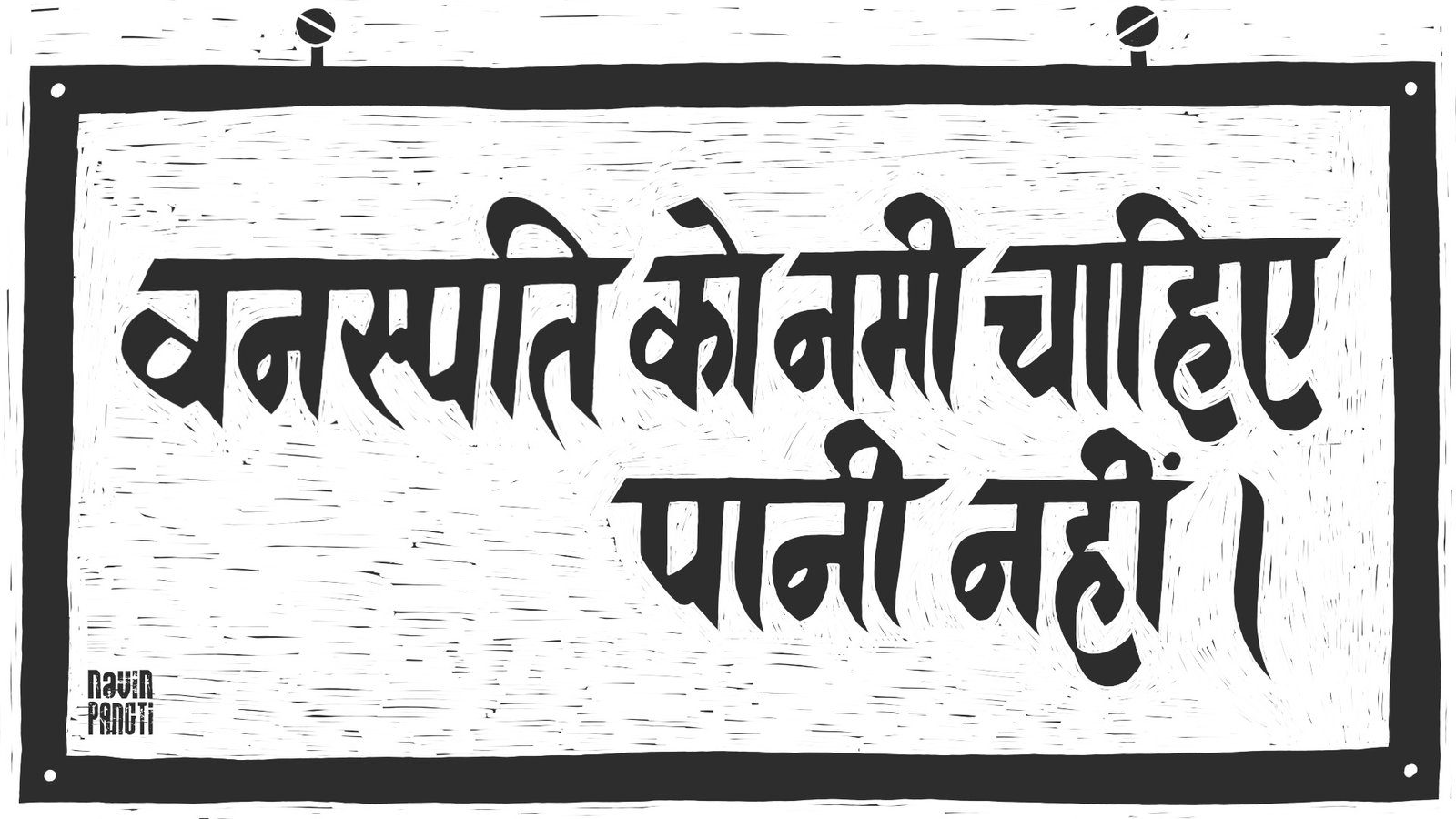From green to evergreen revolution
A well-grounded person does not give up so easily. After sharing his organic farming worldview in the first open letter, Bhaskar Save-ji goes ahead to clear apprehensions and make valuable suggestions in the next two open letters.

Subsequent to his first open letter (Open letter to the green revolution), Bhaskar Save-ji wrote two more open letters. I have taken the liberty of selectively presenting the key parts of these letters. In these letters, Bhaskar-ji responds to queries and criticisms, and also presents constructive suggestions. After making his suggestions, he ends his third and final open letter with these words – “Compromising for less …would be a betrayal of the land and her people, and deep violence to our soils and souls.”
It is worth mentioning here that while Shri MS Swaminathan (Chairman, National Commission on Farmers) responded to the first letter, the commission went silent thereafter. Ideally, as a commission on farmers, it should have opened all the lines of communication. The reasons behind this silence are not known. But it is not hard to guess that it requires a lot of courage to upset the apple cart.
Open Letter – 2
Written on August 16, 2006

I am encouraged that my Open Letter dated July 29, 2006 has generated so much interest. While most people have been appreciative, a few have responded with specific criticisms and/or questions. I address some of these below:
i) Honest Science and Non-invasive Technology
A few people wrote that I should not seem to denigrate all ‘science’ and ‘scientists’, especially reputed figures who have worked for the nation. I clarify that I do not devalue science or scientists per se. But I do believe it is unscientific, indeed hazardous, to uncritically trust ‘scientific authorities’, especially regarding wider safety considerations of commercial or patented technologies and inputs promoted by them.
The kind of technology we need, must be wedded to compassion, foresight and wisdom. It should, first and foremost, do no harm. Additionally, it should empower people to be self-reliant in all basic needs, rather than increase their dependence on and vulnerability to distant, external factors and forces. Hence, maximum emphasis must be given to local needs and rights, and to local, decentralised resources and know-how. Any dependence on external, purchased technologies and inputs especially for our most basic needs like clean water and wholesome food is fraught with grave dangers. This, I believe, is starkly self-evident.
ii) Did not the ‘Green Revolution’ Avert Famine?
It may be more true to say that the ‘Green Revolution’, through ruining our soils and depleting our groundwater, has been progressively creating the conditions for widespread future famine. Mal-distribution, hunger and malnourishment are already with us, despite (or because of) huge, national stockpiles of grains, rotting in our warehouses and feeding rats. But other vital foods (vegetables, fruit, pulses, millets, etc.) are all in short supply. Thanks to the ‘wheat and rice obsessive Green Revolution’ that its initiators failed to rein in!
All the famines witnessed at certain periods in some regions of our country including the Bengal Famine were largely (if not entirely) man-made. Before Independence, it was excessive colonial exploitation, particularly during periods of war, that was the major cause. Forced cultivation of cash-crops, often for export; high extraction of taxes and levies; consequent neglect of common resources like irrigation tanks, ” etc., were the key factors resulting in villagers going hungry. And even then as today it was mal-distribution, rather than overall scarcity, that was the real culprit. Our heritage of natural resources and traditional farming knowledge, was doubtless among the richest in the world. We certainly did not need any west-bedazzled ‘lab and pulpit’ agricultural scientists telling us how to grow our food.
It has been further pointed out to me that – According to Government records, both the compound annual rates of growth in ‘total production’ as well as ‘productivity’ (yield per unit area) including ‘all’ crops for India as a whole, were higher in the decade before the ‘green revolution’ kicked in, compared to the decade that followed.
In the First Plan period (1951 to 1956), India’s farm production increased at the compound rate of 4.1% per annum, while productivity increased at the compound rate of 1.4% per annum. In the Second Plan period (1956 to 1961), production increased at the compound rate of 3.1% per annum, while productivity increased at the compound rate of 1.8% per annum. During the Third and Fourth Plan periods combined (1961 to 1973, the first GR decade), the comparative increase in production was just 2% per annum, while the increase in productivity was 1.3% per annum. (Source: ‘Handbook of Agriculture’, Indian Council of Agricultural Research (ICAR), 1987, pg. 105)
iii) Modern Biotechnology is Perilous
One or two responses pointed out that agro-chemicals are, in any case, becoming fast outdated, and widely recognized as destructive and unsustainable. Now, it is modern biotechnology, posing as the new saviour of the farmer, that promises (or threatens) to usher in a ‘Second Green Revolution’. This is the latest booming avenue of agro-industry. The new biotech prescriptions (more expensive inputs and greater external dependence) retain the old mentality of trying to engineer nature to our immediate (short-term) convenience. This can have adverse effects at levels other than those considered by the narrow-focused bio-technologies.
By its very mandate, the bio-engineering approach especially genetic manipulation strives to maximise the ‘performance’ of certain essentially limited features, not knowing what the wider consequences may be. But nature works through the interplay of an incomprehensibly vast array of factors, far beyond the professional concerns or cognitive reach of genetic engineers. While bio-technologists may have certain economic or political interests in mind, they can’t even begin to imagine trying to forge an overall balance that fosters health — the mysterious harmony of diverse elements and forces.
Some of the mind-boggling dangers of genetic engineering have become fairly clear. More seem likely to reveal themselves. The threat too of invasive ‘genetic pollution’ of our natural biodiversity (both cultivated crops and uncultivated species) is no longer in the realm of science fiction. If only we see that there is nothing lacking in the genetic code of the myriad time-tested species gifted by Nature, we would realize that there is no need whatsoever to tamper with their DNA ribbon of life. And that much saner and happier paths exist to provide for the well being of people.
iv) ‘Gradual Reduction’ of Chemicals is not Good Strategy
Some have asked whether chemicals should not be gradually reduced, instead of totally stopping them suddenly. But while less of the chemicals may cause less damage to the soil, they are still harmful. The land will continue to worsen, though less rapidly.
The turning point, where destruction stops, and the soil begins to regain its health, can only be reached by totally stopping the use of what is poison to the organic life of the earth. The micro-organisms, earthworms, etc then gradually regenerate, rebuilding the humus of the land. This is the very basis of soil health, without which healthy plants and wholesome food cannot be grown.
Most of the farmers I have met, who use chemicals, can clearly see that they are on a downward slide. But they seem to lack the confidence of changing their way of farming. My suggestion to them is that they should at least make a start by totally stopping chemicals on a part of their land, using instead whatever organic inputs are available.
In the very first year, even if the yields fall to less than half, the big saving in costs will ensure that there is no significant loss. The yields then continue to improve, while costs further decline. By the end of the second or third year, the improvement in net gain is clear. And if the organic produce is consumed by the farmer’s own family, this itself is an incalculable benefit to health. As the farmer’s experience and confidence increases, additional land can be converted to the organic way in a phased manner. The more concentrated use of the available organic inputs on one new plot each year also hastens the regeneration and productivity of the soil. Hence, the farmer is not discouraged by the initial results.
Open Letter – 3
Written on October 9, 2006

…you have acknowledged the pitfalls of the chemical based ‘green revolution’ technology, and mentioned the need for an ‘evergreen’ revolution. By this, I hope you mean a way of farming, and an ethic of land use, that causes no harm; and thus promises sustained yield of wholesome food that does not just fill the belly, but provides vital nourishment to body, mind and spirit.
You will agree that for 9,950 years of our ten millennium old agricultural history, India actually followed such a cultural ethic and way of farming.
Where on earth, in its entire agricultural history, can you find any significantly different way of farming that has a stronger claim to being evergreen?
Of course, we have been – and still are – extremely fortunate to have an abundance of sunshine all-round the year, a wealth of biodiversity, and more than adequate rainfall. The luxuriance of our untended natural forests is eloquent testimony to what can be achieved in this country if our numerous unnatural interventions stop!
…you have touched on half a dozen pathways which – according to you – may be considered for pursuing an ‘evergreen revolution’. The first one you mention is a hundred percent organic path, where no chemicals whatsoever are used, but which is distinct from pure, ‘do-nothing natural farming’, as it may still entail some seasonal tillage, manual weed control, and perhaps non-chemical ‘pest control’.
The last pathway mentioned is the no-tillage path of natural farming. While the cultivation of seasonal field crops without any tillage whatsoever, is problematic in most parts of India, natural farming is definitely possible to achieve with tree crops.
Once the tree saplings or seeds are planted, and a ground cover of vegetation established, all tillage is totally taken care of by Nature, with no human intervention needed for this. Some other tasks like mulching, manuring, etc. may still be needed in the first few years, which is thus a transitional, organic phase. But by the time the saplings start yielding, almost nothing is required to be done, except perhaps conservative irrigation for some crops like coconut, chikoo, banana. Many food tree species like mango, jambul, ber, cashew, drumstick, awala, custard apple, mahua, etc. do not require even this, particularly after their first year. They are as natural as our old forests.
It is thus necessary to start with 100% organic farming, which would continue for field crops, but which would evolve into a progressively purer form of natural farming for most tree crops. This is the combination of pathways we must follow to regain an evergreen agriculture. While you have also mentioned other ‘pathways’ which combine chemicals with organic inputs, and natural with unnatural, I am afraid they are blind alleys and not true paths to an evergreen future.
I am summarizing below the suggestions and recommendations I can offer with full conviction, based on many decades of intimate personal experience. I do trust these will lead to the revitalization of India’s agriculture and natural wealth, and hope they help you in drafting the proposed national policy for farmers.
Suggestions/Recommendations
- The major thrust of our national policy should be to ensure the water security and food security of India through organically growing mixed, locally suitable crops, plants, and particularly trees, following the laws of Nature.
- The Government should provide all necessary encouragement and support to the farmers presently using chemicals, for converting at least 20-25% of their land each year to a 100% organic path without any chemicals whatsoever. It is thus possible for India to be wholly (and happily) liberated from the poisonous agro-chemicals in about 4-5 years.
- We should restore (organically) at least 30% ground cover of mixed, indigenous and locally adapted trees and forests, preferably within the next decade, especially on sloping lands prone to soil erosion. This is the core task of ecological water harvesting – the key to restoring the natural abundance of groundwater. Outstanding benefits can be achieved thereby in the shortest possible time at minimal cost. Such decentralized underground storage is more efficient, as it is protected from the high evaporation of surface storage. The planting of trees will also make available a variety of useful produce to enhance the welfare of a larger number of people. By inter-planting short life-span, medium life-span, and long life-span crops and trees, it is possible to have planned continuity of food yield to sustain a farmer through the transition period till the long-life fruit trees mature and yield. The higher availability of biomass and complete ground cover round the year will also hasten the regeneration of soil fertility.
- A policy of conservative irrigation must be strictly followed, according highest priority of allocation to nutritious food crops. Indeed, most crops grow best when the soil is just damp, enabling continuity of soil aeration. A high water consumption field crop like rice should be cultivated only in the monsoon, when it is a logical choice for growing in low-lying areas, prone to inundation. The unseasonal cultivation of rice with irrigation in dry months should stop, or at least be phased out within the next five years. Growing sugarcane in water scarcity areas must be banned, as also in poorly drained soils and dry climates with a high rate of evaporation. By this policy, at least 60% of our irrigation waters can be saved for local priority use. The irreversible ruination of fertile agricultural lands through soil salinisation and water-logging will also stop.
- High priority is needed to conserve in their decentralized natural habitats – and within the control of local farmers – the enormous wealth of our biodiversity, both of crops and uncultivated species.
- Similarly, we urgently need to document from experienced organic farmers the depth of traditional farming knowledge specific to each bioregion and agro-climatic zone.
- No unnatural biotechnological interventions whatsoever are needed. These, particularly genetically tampered species, may prove even more dangerous to our food sovereignty than have the chemicals.
- Soil erosion needs to be checked on a war footing. Official records inform that presently over 350 million acres of land are seriously affected by soil erosion caused by rain and wind. The most effective and productive strategy of checking such erosion is by establishing ground cover vegetation, particularly perennials.
- All crop residues and ‘bio-wastes’ must go back to the land to replenish its fertility. The drain of organic matter from our soils must stop.
- Technology can be harnessed to provide farmers with good, manual tools and implements, which can greatly help to increase work efficiency and reduce the toil. Continuous feedback should be obtained from farmers on what they find helpful.
- Local farmer-level exchanges of experiences, skills and seeds should be encouraged and supported by the government. Again, the farmers themselves are the best judges of what support, if any, they need.
- Urban areas should be encouraged to vermi-compost their kitchen wastes and grow organic vegetable gardens in rooftops and open spaces. Additionally, urban educational institutes should facilitate practical understanding and work experience related to the regeneration of our natural wealth. For this purpose, academic leave may be granted for spending at least 15 days every year in the countryside. Schools in rural areas should preferably have monsoon vacations for about 45 days, starting a week before the rains – to enable the rural populace to concentrate on farming and planting work, which cannot be undertaken the rest of the year.
It is perhaps unrealistic to hope for total, voluntary change in a hurry. But if we can achieve even 50% of the tasks listed above, our farmers have a fighting chance. Compromising for less than that would be a betrayal of the land and her people, and deep violence to our soils and souls.
I have shared the first open letter in the article – Open letter to the green revolution. I have also shared one of the annexures to that letter which outlines 18 differences between chemical and organic farming.
To know more about Bhaskar-ji’s ways of farming and his worldview, one should read ‘The vision of Natural Farming’ written by Bharat Mansata and published by Earthcare Books.














